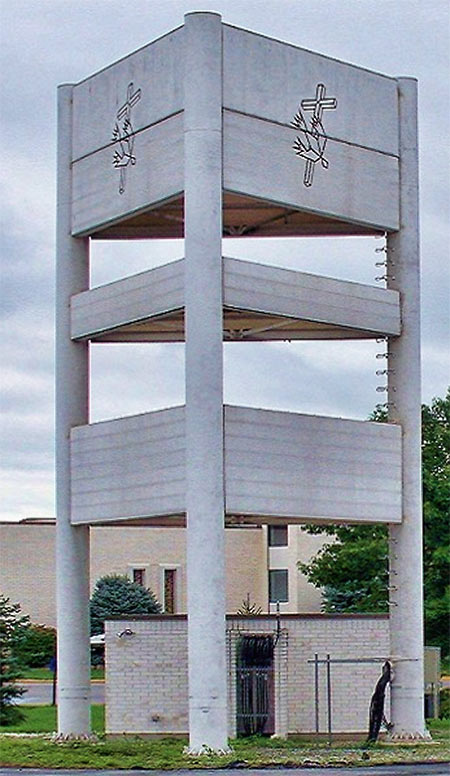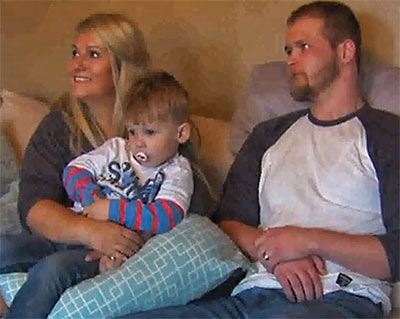
Thomas Jeglum was seriously injured when he fell from the top of this stealth cell tower in Pennsylvania. His lawsuit includes AT&T, Inc. as well as AT&T Mobility LLC as defendants. AT&T, Inc. says it is not the legal entity for the lawsuit since it is a holding company.
AT&T, Inc. was denied its request last week to be removed from a personal injury lawsuit brought by Thomas Jeglum, 26, against the company in the First Judicial District of Pennsylvania after the California tower tech suffered serious injuries when he fell in 2013 from a stealth tower site in Allentown, Pa. while performing an AT&T Mobility LTE upgrade.
Judge John M. Younge had met with the plaintiff’s and a defendant’s attorneys on Nov. 4, and overruled AT&T, Inc.’s motion requesting that it had “no presence” in the state of Pennsylvania and therefore the case lacks general and specific jurisdiction and AT&T should not be a defendant in the lawsuit.
AT&T Mobility LLC is also named as a defendant in the lawsuit, along with B+T Group and B+T Engineering, Inc., associated companies located at the same address in Tulsa, Okla.; and Calvary Temple whose property the structure is located upon.
B+T was included in the lawsuit because they allegedly “inspected, evaluated, audited, designed, constructed, and/or managed the construction work of or at the telecommunications tower.”
Although none of the defendants are specifically noted as owning the structure, AT&T, Inc., AT&T Mobility and Calvary Temple, according to the complaint, “owned, leased rented, managed, maintained, controlled, and/or was in possession of the telecommunications tower” located at 3436 Winchester Rd. in Allentown.
Although tower ownership would appear to be the optimal way to establish liability, the plaintiff’s attorneys will be pursuing other methods to substantiate liability.
Decree against AT&T, Inc. might only be temporary
The court’s decision that AT&T, Inc. must prove that it is not liable for the resulting injuries might be short-lived, however, if attorneys for Jeglum can’t show through a newly found lease agreement that AT&T, Inc. owns the tower that Jeglum fell from, conducts business in Pennsylvania, or if AT&T, Inc. proves to the court that it can’t be held responsible for the actions of its subsidiaries.
On Sept. 25, 2015, Jeglum’s attorneys provided the court with a copy of a 1996 agreement with Calvary Temple of Allentown from Pennsylvania Cellular, the lessee, indemnifying the church, with: “The parties hereto have agreed that the Lessee will indemnify and hold harmless the Lessor for all liability, damages, expense or claims resulting from the use and occupancy of the demised premises by lessee if caused by the negligence of the Lessee, its agents, employees, invitees, or guests during the term of the Agreement.”
Calvary Temple also indemnified Pennsylvania Cellular relating only to negligence by the lessee.
The 1996 memorandum of agreement might indicate that Calvary Temple owns the tower: “…the parties agree that all improvements constructed, erected or placed by the Lessee on the Demised Premises, but for the bell tower structure, shall remain the property of the Lessee…”.
However, a second unsigned addendum appears to show AT&T attempting to sublease space on the tower to Nextel and expanding the structure’s height: “…Whereas Lessor and Lessee desire to amend the Agreement to modify the definition of the Demised Premises in order to accommodate an extension (from fifty feet (50′) Above Ground Level to Sixty-Five feet (65′) Above Ground Level) of Lessee’s existing antenna suport structure (the “Bell Tower”)…”.
The unexecuted agreement had Vanguard Cellular and McCaw Communications that acquired Pennsylvania Cellular as lessees with Calvary Temple as the lessor.
Through acquisitions, McCaw and Vanguard were rolled up under the ‘AT&T’ umbrella. The 15-foot increase to accommodate Nextel’s antennas was never completed..
Jeglum’s attorneys said that they needed time from the court, based upon the recently obtained lease agreement, to see “whether defendant AT&T Inc. not only does business in Pennsylvania, but also has a direct ownership interest in the Cell Tower that is the subject of this litigation,” and they were provided that time by Judge Younge when he overruled AT&T.
A cell tower lease consulting expert noted that it is uncommon for a lessor such as Calvary Temple to retain ownership of the bell tower structure when they enter into a cell tower lease with a carrier.
“Were this a steeple, the church would normally retain ownership of the steeple as it is part of the church. However, with fake bell tower or religious cross tower structures, the wireless service provider normally retains ownership. If Calvary Temple did own the structure, then they would have retained the right to lease to other wireless service providers on the bell structure,” said Ken Schmidt, President of Steel in the Air, Inc.
AT&T asserts that it is not the tower owner
An executive from AT&T Services, Inc. previously provided an affidavit to the court explaining the autonomy of AT&T Inc. in reference to its subsidiaries, specifically AT&T Mobility LLC.
Like many of America’s corporations — such as Bechtel Corporation, CommScope and Jacobs Engineering Group — AT&T is a holding company that is protected from the actions of its dozens of subsidiaries.
When Jeglum was working on what his attorneys state could possibly be an AT&T Mobility-owned stealth bell tower on Calvary Temple church property in Allentown, according to his sworn statement, he was climbing to the top of the 51-foot structure when a “detachable rung” on which he had been standing had “failed, fallen, and/or slipped out of place,” when he fell and suffered many injuries including a traumatic brain injury.
AT&T said it wasn’t properly named and AT&T Mobility says that the lawsuit isn’t justified in their response to the complaint. A news article in the PennRecord last Thursday stated that AT&T, Inc. was asking the court to be removed as a defendant, but Judge Younge had already denied AT&T’s motion. Industry media republished the article, inferring that AT&T wanted the lawsuit “thrown out,” and social media quickly excoriated AT&T.
Nonetheless, one industry safety executive doesn’t believe that AT&T, Inc. has a role in the lawsuit and said, “The villagers are needlessly sharpening their pitchforks. I’m no attorney, but I believe the AT&T attorney was only making the point that the plaintiff is litigating against the wrong legal entity.”
U.S. Supreme Court ruling bolsters AT&T Inc.’s argument
The United States Supreme Court appears to be on the side of AT&T, Inc. if Jeglum’s attorneys can’t prove that it owned the tower.
The basic rule observed by courts is that the parent corporations will not be liable for acts of their subsidiaries. The Supreme Court emphasized this basic premise by ruling in a decision in 1998 that: “It is a general principle of corporate law deeply ingrained in our economic and legal systems that a parent corporation is not liable for the acts of its subsidiaries.”
As examples of the separation between AT&T, Inc. and its subsidiaries, in 2011, AT&T Mobility announced its intention to acquire T-Mobile USA from Deutsche Telekom for $39 billion, not AT&T, Inc. the holding company. When Crown Castle International acquired the rights to AT&T’s towers in 2013, AT&T’s press release started with “AT&T* announced,” but the asterisk after AT&T identified that “*AT&T products and services are provided or offered by subsidiaries and affiliates of AT&T Inc. under the AT&T brand and not by AT&T Inc.”
AT&T Mobility says the tower wasn’t owned by them
In a Sept. 3, 2015 filing, AT&T Mobility, represented by a separate law firm, denied that it “owned, leased, rented, managed, maintained, controlled and/or was in possession of the telecommunications tower,” as stated in the lawsuit, and the carrier is demanding “strict proof” at trial.
But after the Calvary Temple lease agreement surfaced, on Sept. 24, 2015 Jeglum’s attorneys contacted AT&T Mobility and their counsel said “they are looking into it.”

Thomas Jeglum with his wife, Regina, and one of their two children. He was in a coma for two months following the accident and still has serious health problems.
100% tie-off could have prevented the incident
Jeglum’s lawsuit points out multiple steps that all of the defendants could have taken to prevent the incident such as:
- Failure to install a permanent-rung ladder
- Failure to install a safety cage and/or guard rail
- Failure to install a permanent safety cable or vertical lifeline
- Failure to install fall protection systems on the tower
- Failure to appropriately protect workers from falls
- Failure to provide a safe means of access and egress
- Failure to inspect the cell tower
They also identified 21 more areas of alleged corporate malfeasance that could have prevented Jeglum’s injuries, some of them impractical or not required by OSHA or specified in industry standards.
Although Jeglum’s attorneys are not required to provide any details in their complaint that will not advance their position, the question that will be required to be answered at some point is, was he tied off 100% at all times, a required industry practice that is oftentimes ignored and is the cause of the majority of industry deaths?
Workers compensation system protects Jeglum’s employer from being sued
When he fell, Jeglum was employed by a subsidiary of Jacobs Engineering, JTI Telecommunications Inc. (JTI). Although the company was cited by OSHA for violations, it is not a defendant in the lawsuit since Jeglum is barred from suing them for a workplace injury because when employers provide workers compensation insurance for the benefit of their employees, they are typically protected from defending personal injury claims brought by those employees.
The workers compensation system was established as a trade-off in which injured employees give up their right to sue employers in court in exchange for the right to receive workers compensation benefits, regardless of who was at fault for their injuries.
The only exception is if a worker can prove that his employer intentionally caused them harm. Carelessness, even in the most extreme forms, is still insufficient to sue.
After Jeglum fell, his wife, Regina, then his fiancée, during an interview with Wireless Estimator related a different scenario of how the accident happened than what is offered in the lawsuit.
Regina said, “What I was told in the hospital was when Tommy hooked on to it (the step), that it did not support his weight and came out of the structure and made him fall.”
The lawsuit states the climbing attachment, as can be seen in the top photograph, which appears to be a tubular bracket step, unlike the most commonly installed step bolt used on many steel structures, pulled out of a concrete pier when Jeglum was standing on it.
The lawsuit acknowledges that Jeglum wore “personal fall protection equipment, including a harness with a double-legged Y-lanyard and double-locking offset snap hooks.”
JTI Telecommunications walks away with only a $7,000 fine
Jeglum was hired on April 28, 2013 and the accident occurred on June 15, 2013. During that 48-day period, according to Regina, he did not have any climber training from JTI.
She said at the time of his hire he was informed by JTI that they would be sending him to a recognized training company for formal training, but Jeglum fell before he received that training. Regina said he should not have been on any tower without formal training.
OSHA, according to their serious citation issued to JTI, appears to corroborate Regina’s statement. The agency cited JTI for not complying with 1910.268(c), a regulation that requires employers to provide training in the various precautions and safe practices and be able to provide OSHA with certification that Jeglum was properly trained for climbing.
They also cited JTI under 1910.268(h)(6), a regulation for climbing ladders or stairways on scaffolds, and the company was given a $7,000 fine which it contested, but was required to pay in a formal settlement.
The inspection was only opened after a complaint was filed with OSHA. The case was closed on Sept. 17, 2014.
Were opportunities available to rig a safety line?
Where Jeglum was working inside the shroud there was a platform on the 51-foot tall bell tower.
From a Google satellite view it appears that access could have been made from the open top of the tower with an appropriate man-rated lift or crane with a man basket to rig a safety line so that it could be provided to ensure 100% tie-off for workers using the step brackets to ascend the structure.
The requirement for all new structures to have safety climb cable devices wasn’t required until 2006.
Those details will be presented and challenged in court, if the case goes before a jury trial. As with most civil complaints, however, it will most likely be settled at the eleventh hour when a jury is ready to be picked.
AT&T is taking an active role in worker safety
For a number of years, AT&T Mobility has been the carrier that has been most actively involved in worker safety in the wireless construction industry.
Their director of national cell site programs, Art Pregler, who manages a nationwide portfolio of 65,000 cell sites, is Chairman of the Board of Governors for the National Wireless Safety Alliance and is a board member of the Telecommunications Industry Registered Apprenticeship Program.
AT&T Mobility will not comment upon ongoing lawsuits.
In a statement following Jeglum’s accident, an AT&T spokesperson said: “AT&T hires companies that are experts at tower construction and maintenance, and requires them to abide by standards that reflect our focus on worker safety. In addition to strict compliance with state and federal laws and regulations, our contractors must fully train and conduct background tests and drug screens on those working on AT&T projects. Contractors who violate the conditions of their contracts are subject to termination.”

















